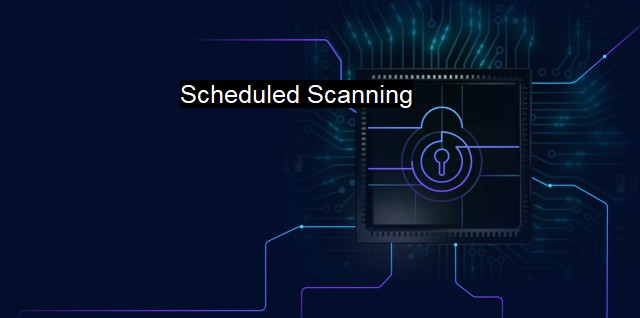What is Scheduled Scanning?
The Importance of Scheduled Scanning for Efficient Cybersecurity: Keeping your System Safe from Malicious Threats
Scheduled scanning, as it relates to cybersecurity and antivirus software, is a process that involves routine or periodic scanning of a computer system, network, or application to detect any potential vulnerabilities, malware, or harmful threats. This form of scanning is a significant aspect of effective cybersecurity strategies and tactics, as proactive and regular scanning helps in identifying and combating possible threats, thereby ensuring the safety and security of the system and data they handle.Scheduled scanning can be executed and managed via antivirus or cybersecurity software. Generally, the software allows users to set up a schedule, either daily, weekly, or monthly, whereon the system will automatically perform scanning. The core objective of these scheduled scans is to capture any malicious items that might have been introduced to your computer in between the real-time scans or updates in the user's system.
This strategy is imperative for enhancing an organization's or individual's cybersecurity landscape. In itself, the nature of cybersecurity threats is evolving, with hackers and cybercriminals frequently using advanced and sophisticated methods to exploit systems. Organizing scheduled scans aids in keeping pace with such developments and minimizes the potential damage that may result from new viruses or malware leading to data security breaches.
In this light, it is worth considering that scheduled scanning is not just any cursory scanning process. It is an extensive and in-depth scanning strategy that scrutinizes the systems down to individual files and directories. The scans review files and folders, examine scripts and codes, and check for any anomalies or suspicious activities. Scanning can shed light on many potential security issues, including viruses, spyware, ransomware, phishing attacks, adware, Trojans, and other types of malware.
An effective scheduled scanning strategy does more than just run routine scans; it also involves consistent updates to adapt to the ever-changing threat landscape. Antivirus or cybersecurity software is updated regularly to include defense mechanisms against new and emerging threats. With each update, the program enhances its ability to effectively identify and weed out threats during scheduled scans.
Scheduled scanning offers a robust line of defense when paired with real-time protection. While real-time protection provides instant security by scanning files when they are downloaded, opened, or executed, scheduled scans are an additional security layer, identifying threats that might have gone unnoticed or occurred during downtime. This two-pronged approach can significantly lessen the risk of harmful attacks and data breaches.
It must be underlined that an efficient scheduled scanning approach involves predictive and proactive measures and recognises that addressing cybersecurity threats goes beyond merely reacting to attacks. Instead, it takes the initiative to scan and identify threats, producing an exhaustive report detailing identified threats and actions taken. Sometimes, an automated resolution like quarantining or deleting malicious files may be pursued.
Importantly, too, scheduled scanning avoids overwhelming the system during peak hours. The scans can be set to occur during off-peak hours when the user is less likely to be actively using the system. This aspect of scheduled scanning ensures that system performance is unhindered by the process, avoiding potentially slowing down or other negative impacts on user experience during key usage times.
The advent and prevalence of cybersecurity threats have made scheduled scanning a crucial measure in securing computer systems, networks, and even applications. While the actual scanning process is primarily within the purview of the antivirus or cybersecurity software, the user plays a critical role in determining the scan's frequency and managing incidents flagged by the software. As the dynamics of cyber threats continue to evolve, every user must understand the importance of scheduled scanning, its role in effective cybersecurity hygiene, and the protection of valuable data and information.

Scheduled Scanning FAQs
What is scheduled scanning and how does it help in cybersecurity?
Scheduled scanning is an automated process that checks a computer or network for viruses and malware at predetermined times. It helps in cybersecurity by detecting threats before they cause damage, and ensures that the system remains protected and up-to-date.How often should I schedule scans on my computer?
It is recommended to schedule scans at least once a week to ensure comprehensive protection. However, the frequency may vary depending on the amount of internet usage and the sensitivity of the data stored on the computer.Can I schedule scans for specific folders or files on my computer?
Yes, most antivirus software allows you to schedule scans for specific folders or files on your computer. This is useful if you suspect that some files may be infected, or if you want to scan only certain areas of your computer.What happens if a threat is detected during a scheduled scan?
If a threat is detected during a scheduled scan, the antivirus program will alert the user and quarantine the infected file to prevent further damage. Some antivirus programs may also attempt to repair the infected file. In some cases, the antivirus may require additional action from the user, such as deleting the infected file or running a full system scan.| | A | | | B | | | C | | | D | | | E | | | F | | | G | | | H | | | I | | | J | | | K | | | L | | | M | |
| | N | | | O | | | P | | | Q | | | R | | | S | | | T | | | U | | | V | | | W | | | X | | | Y | | | Z | |
| | 1 | | | 2 | | | 3 | | | 4 | | | 7 | | | 8 | | |||||||